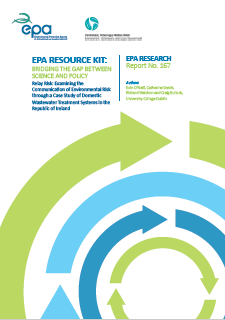Relay Risk: Examining the Communication of Environmental Risk through a Case Study of Domestic Wastewater Treatment Systems in the Republic of Ireland
Summary: The report examines the elements required for the preparation, implementation, and monitoring of an engagement strategy aimed at communicating risk-based environmental regulation of domestic wastewater treatment systems to owners of such systems. The report is aimed at regulators, national and local authorities, and policy makers, particularly those involved in environmental risk communication, management and assessment

There are approximately 500,000 septic tanks in operation in Ireland. Septic tanks not operated and maintained adequately can pose economic, environmental and social risks. The fundamental objective of this project was to explore and identify how to effectively communicate environmental risk, by focusing on the case study of domestic wastewater treatment systems (DWWTS) in the Republic of Ireland. Risk communication aims to address the divergence in how risk is perceived between expert and lay positions, and when carried out effectively, it empowers individuals to recognise and manage risk. By identifying what influences householder behaviour regarding their DWWTS, it is possible to formulate a communication approach that aims to improve compliance with environmental regulation, thus protecting human health and the environment.
The findings from this research suggest that understanding the public’s perception of risk is central to the successful implementation of risk-based environmental regulation. One output is a set of guidelines on how to effectively communicate risk that relates to DWWTS. The guidelines are transferable to other areas of risk-based regulation, to facilitate effective communication of risk-based environmental regulation in Ireland, particularly in policy contexts that require public involvement to achieve regulatory objectives.
You can also view the accompanying guidelines to this report.
https://www.epa.ie/media/epa-2020/publications/research/167_web_image[1].png